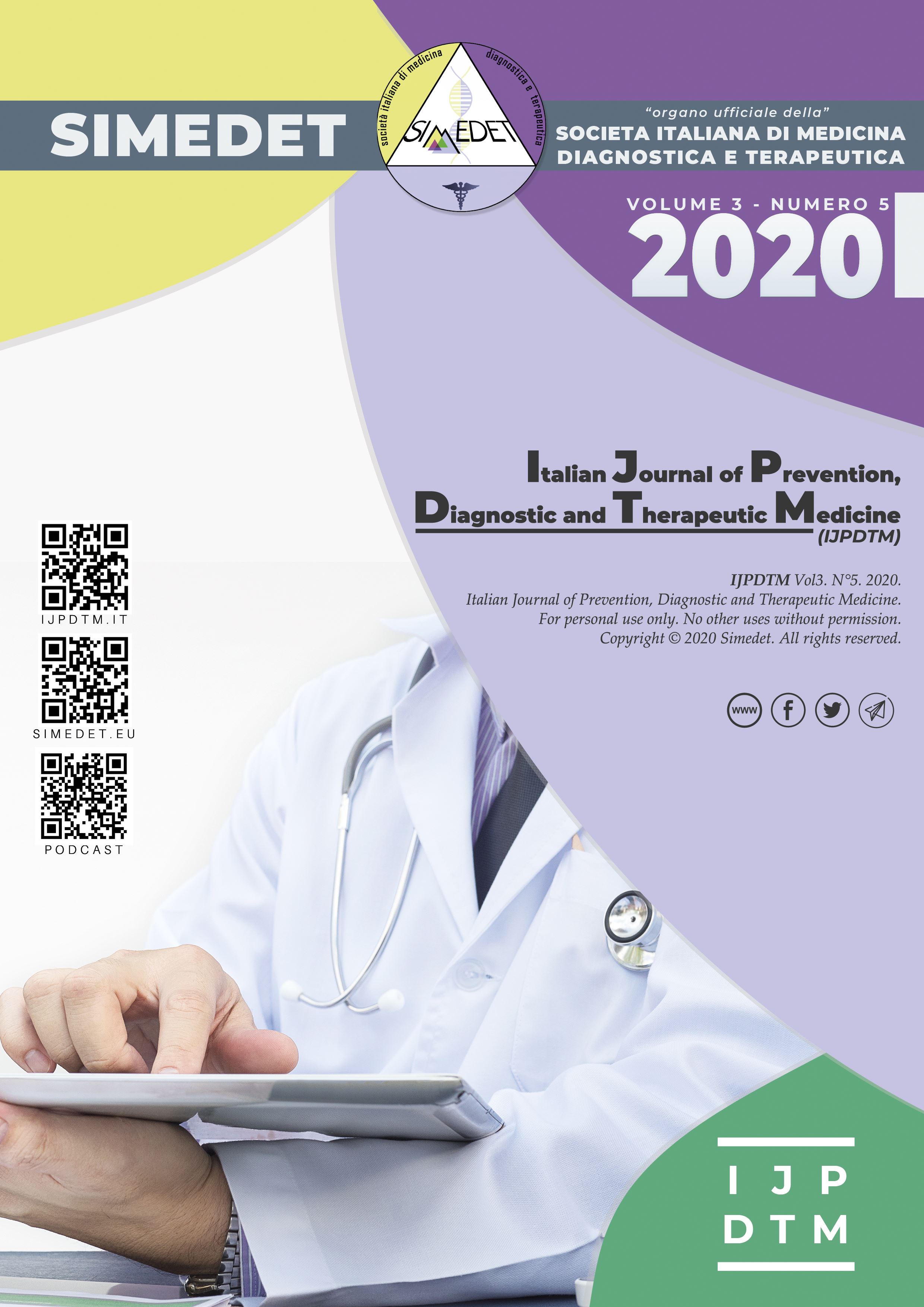The knowledge on blsd maneuvers of university students descriptive observational study
Main Article Content
Abstract
Introduction: Early defibrillation and cardiopulmonary resuscitation are the most effective actions for the treatment of cardiac arrest, one of the most widespread health problems in Europe. Although the prevalence of public access defibrillation stations has increased over the years, their use by the population is still rather limited, with a possible negative impact on the survival of cardiac arrest victims.
Objective: Investigate the knowledge related to CPR (Cardiopulmonary Resuscitation) and the use of AED (External Automatic Defibrillator) of students at the University of Padua in order to identify the main barriers that hinder the implementation of resuscitation maneuvers.
Methods: Descriptive observational study. An online questionnaire was administered to 40 university groups, both health and non-health degree courses, through the use of a social platform. The questionnaire consists of 21 questions, each one aimed at testing the knowledge related to the first aid. The sample analyzed is composed of 390 students.
Results: The main obstacles to the execution of resuscitation manoeuvres were the fear of causing harm to the victim, inadequate location and poor visibility of PAD (Public Access Defibrillation) stations, lack of training and fear of legal repercussions.
Discussion: The level of knowledge related to first aid has proved to be better among students enrolled in health degree courses, who have also shown a greater willingness to perform resuscitation manoeuvres if necessary. Nevertheless, the main obstacles to first aid were indicated equally by all students and are reflected in the results of the literature.
Conclusion: First aid training and education must be developed and encouraged in order to make the population more aware and sensitive to first aid, together with an even more widespread and careful dissemination of public access defibrillators. Further studies with a larger sample are needed in order to extend the results to the general population.
Downloads
Article Details

This work is licensed under a Creative Commons Attribution-NonCommercial-NoDerivatives 4.0 International License.
References
Gräsner JT, Lefering R, Koster RW, Masterson S, Böttiger BW, Herlitz J et al. EuReCa ONE – 27 Nations, ONE Europe, One Registry. A prospective one month analysis of out-of-hospital cardiac arrest outcomes in 27 countries in Europe. Resuscitation, 2016, 105: 188 – 195.
Monsieurs KG, Nolan JP, Bossaert LL, Greif R, Maconochie IK, Nikolaou NI et al. European Resuscitation Council Guidelines for Resuscitation 2015: Section 1. Executive summary. Resuscitation, 2015, 95: 1 – 80.
Pollack RA, Brown SP, Rea T, Aufderheide T, Barbic D, Buick JE et al. Impact of Bystander Automated External Defibrillator Use on Survival and Functional Outcomes in Shockable Observed Public Cardiac Arrests. Circulation, 2018, 137: 2104 – 2113.
Claesson A, Herlitz J, Svensson L, Ottosson L, Bergfeldt L, Enqdahl J et al. Defibrillation before EMS arrival in western Sweden. Am J Emerg Med, 2017, 35: 1043 – 1048.
Murakami Y, Iwami T, Kitamura T, Nishiyama C, Nishiuchi T, Hayashi Y et al. Outcomes of out-of-hospital cardiac arrest by public location in the public-access defibrillation era. J Am Heart Assoc, 2014, 3 (2).
Lijovic M, Bernard S, Nehme Z, Walker T, Smith K. Public access defibrillation –results from the Victorian Ambulance Cardiac Arrest Registry. Resuscitation, 2014, 85: 1739 – 1744.
Ringh M. Jonsson M, Nordberg P, Fredman D, Hasselqvist-Ax I, Håkansson F et al. Survival after Public Access Defibrillation in Stockholm, Sweden - A striking success. Resuscitation, 2015, 91: 1 – 7.
Bækgaard JS, Viereck S, Møller TP, Ersbøll AK, Lippert F, Folke F. The Effects of Public Access Defibrillation on Survival After Out-of-Hospital Cardiac Arrest: A Systematic Review of Observational Studies. Circulation, 2017, 136: 954 – 965.
Capucci A, Guerra F. Out-of-hospital cardiac arrest and public access defibrillation. J Cardiovasc Med, 2014, 15: 624 – 625.
Deakin CD, Anfield S, Hodgetts GA. Underutilisation of public access defibrillation is related to retrieval distance and time-dependent availability. Heart, 2018, 104: 1339 – 1343.
Malta Hansen C, Wissenberg M, Weeke P, Ruwald MH, Lamberts M, Lippert FK et al. Automated external defibrillators inaccessible to more than half of nearby cardiac arrests in public locations during evening, night time, and weekends. Circulation, 2013, 128: 2224 – 2231
Sun CL, Demirtas D, Brooks SC, Morrison LJ, Chan TCY. Overcoming Spatial and Temporal Barriers to Public Access Defibrillators Via Optimization. J Am Coll Cardiol., 2017, 68: 836 – 845.
Sidebottom DB, Potter R, Newitt LK, Hodgetts GA, Deakin CD. Saving lives with public access defibrillation: A deadly game of hide and seek. Resuscitation, 2018, 128: 93 – 96.
Gonzalez M, Leary M, Blewer AL, Cinousis M, Sheak K, Ward M. Public knowledge of automatic external defibrillators in a large U.S. urban community. Resuscitation, 2015, 92: 101 – 106.
Brooks B, Chan S, Lander P, Adamson R, Hodgetts GA, Deakin CD. Public knowledge and confidence in the use of public access defibrillation. Heart, 2015, 101: 967 – 971.
Ballesteros-Peña S, Fernández-Aedo I, Pérez-Urdiales I, García-Azpiazu Z, Unanue-Arza S. Knowledge and attitudes of citizens in the Basque Country (Spain) towards cardiopulmonary resuscitation and automatic external defibrillators. Med Intensiva, 2016, 40: 75 – 83.
Shams A, Raad M, Chams N, Chams S, Bachir R, El Sayed MJ. Community involvement in out of hospital cardiac arrest: A cross-sectional study assessing cardiopulmonary resuscitation awareness and barriers among the Lebanese youth. Medicine, 2016, 95:43.
Smith CM, Lim Choi Keung SN, Khan MO, Arvanitis TN, Fothergill R, Harthley-Sharpe C et al. Barriers and facilitators to public access defibrillation in out-of-hospital cardiac arrest: a systematic review. Eur Heart J, 2017, 3: 264 – 273.
Fan KL, Leung LP, Poon HT, Chiu HY, Liu HL, Tang WY. Public knowledge of how to use an automatic external defibrillator in out-of-hospital cardiac arrest in Hong Kong. Hong Kong Med J, 2016, 22: 582 – 588.

